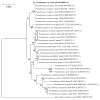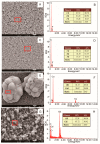Recovery of Metals from Acid Mine Drainage by Bioelectrochemical System Inoculated with a Novel Exoelectrogen, Pseudomonas sp. E8
- PMID: 31878294
- PMCID: PMC7023207
- DOI: 10.3390/microorganisms8010041
Recovery of Metals from Acid Mine Drainage by Bioelectrochemical System Inoculated with a Novel Exoelectrogen, Pseudomonas sp. E8
Abstract
Acid mine drainage (AMD) is a typical source of environmental pollution ascribing to its characteristics of high acidity and heavy metal content. Currently, most strategies for AMD treatment merely focus on metal removal rather than metal recovery. However, bioelectrochemical system (BES) is a promising technology to simultaneously remove and recover metal ions from AMD. In this study, both cupric ion and cadmium ion in simulated AMD were effectively recovered by BES inoculated with a novel exoelectrogen, Pseudomonas sp. E8, that was first isolated from the anodic electroactive biofilm of a microbial fuel cell (MFC) in this study. Pseudomonas sp. E8 is a facultative anaerobic bacterium with a rod shape, 0.43-0.47 μm wide, and 1.10-1.30 μm long. Pseudomonas sp. E8 can agglomerate on the anode surface to form a biofilm in the single-chamber MFC using diluted Luria-Bertani (LB) medium as an energy substrate. A single-chamber MFC containing the electroactive Pseudomonas sp. E8 biofilms has a maximum output voltage of 191 mV and a maximum power density of 70.40 mW/m2, which is much higher than those obtained by most other exoelectrogenic strains in the genus of Pseudomonas. Almost all the Cu2+ (99.95% ± 0.09%) and Cd2+ (99.86% ± 0.04%) in simulated AMD were selectively recovered by a microbial fuel cell (MFC) and a microbial electrolysis cell (MEC). After the treatment with BES, the high concentrations of Cu2+(184.78 mg/L), Cd2+(132.25 mg/L), and total iron (49.87 mg/L) in simulated AMD were decreased to 0.02, 0.19, and 0 mg/L, respectively. Scanning electron micrograph (SEM), energy dispersive X-ray spectrometry (EDXS) and X-ray diffraction (XRD) analysis indicate that the Cu2+ and Cd2+ in simulated AMD were selectively recovered by microbial electrochemical reduction as Cu0 (together with trace amounts of Cu2O) or Cd0 on the cathode surface. Collectively, data suggest that Pseudomonas sp. E8 has great potential for AMD treatment and metal recovery.
Keywords: acid mine drainage; exoelectrogen; metal recovery; microbial electrolysis cell; microbial fuel cell.
Conflict of interest statement
The authors declare no conflicts of interest.
Figures










References
-
- Alegbe M.J., Ayanda O.S., Ndungu P., Nechaev A., Fatoba O.O., Petrik L.F. Physicochemical characteristics of acid mine drainage, simultaneous remediation and use as feedstock for value added products. J. Environ. Chem. Eng. 2019;7 doi: 10.1016/j.jece.2019.103097. - DOI
-
- Skousen J.G., Ziemkiewicz P.F., McDonald L.M. Acid mine drainage formation, control and treatment: Approaches and strategies. Extr. Ind. Soc. 2019;6:241–249. doi: 10.1016/j.exis.2018.09.008. - DOI
Grants and funding
- Grant No. 207154/Central South University
- Grant No. 31470230; 51320105006; 51604308/National Natural Science Foundation of China
- No.2017RS3003/Youth Talent Foundation of Hunan Province of China
- No.2018JJ2486/Natural Science Foundation of Hunan Province of China
- 2018WK2012/Key Research and Development Projects in Hunan Province
LinkOut - more resources
Full Text Sources
Molecular Biology Databases

